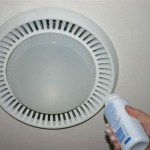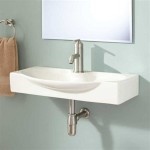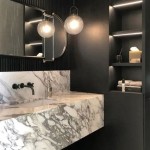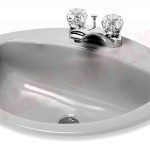Modern Bathroom Basin Ideas: A Comprehensive Guide
The bathroom basin, often referred to as a sink, is a central element in any bathroom design. Beyond its functional purpose, it significantly contributes to the overall aesthetic and ambiance of the space. Modern designs emphasize both form and function, offering a wide array of choices to suit varying tastes, spatial constraints, and design philosophies. This article explores several modern bathroom basin ideas, focusing on trending styles, materials, and practical considerations.
Vessel Basins: Elevated Elegance
Vessel basins, also known as countertop basins, are characterized by their placement on top of a vanity or countertop, rather than being recessed within it. This design choice creates a visually striking focal point and offers a range of aesthetic possibilities. Their exposed form allows for intricate detailing and unique shapes, contributing to a more luxurious and customized bathroom design.
The material options for vessel basins are extensive. Ceramic remains a popular choice due to its durability, ease of cleaning, and ability to be molded into diverse shapes. Stone, such as marble or granite, provides a sense of natural elegance and organic texture. Glass basins offer a contemporary, translucent look, while metals like copper or stainless steel can add an industrial or modern edge. The selection of material should align with the overall bathroom color palette and desired aesthetic.
Installation requirements for vessel basins differ from traditional recessed sinks. They require a specially designed countertop with a pre-drilled hole for the drain. The height of the countertop is also crucial, ensuring comfortable use of the basin without straining. Faucet selection is equally important. Tall, freestanding faucets or wall-mounted faucets are typically paired with vessel basins to provide adequate water flow and reach over the basin's rim.
Considerations should also be given to splash control. Due to their raised position, vessel basins may be more prone to water splashing compared to recessed sinks. Selecting a basin with adequately deep sides and pairing it with a faucet that delivers a gentle, controlled stream can help mitigate this issue.
Integrated Basins: Seamless Simplicity
Integrated basins are designed as a single, seamless unit with the countertop. This design offers a clean, minimalist aesthetic that is easy to maintain and visually appealing. They are often made from materials like solid surface acrylic, resin, or composite materials, allowing for smooth transitions and a unified appearance.
The primary advantage of integrated basins lies in their simplicity and hygienic properties. The absence of seams or joints eliminates crevices where dirt and bacteria can accumulate, making them easier to clean and maintain. This is particularly beneficial in high-traffic bathrooms or those used by individuals with allergies.
Solid surface materials like Corian and Hi-Macs offer excellent durability and stain resistance. They are also non-porous, preventing the absorption of moisture and ensuring a long lifespan. These materials can be molded into various shapes and sizes, providing design flexibility and allowing for customized configurations. Integrated basins can incorporate features like built-in soap dispensers, towel bars, and recessed storage compartments, further enhancing their functionality.
While offering a seamless look, integrated basins typically require professional installation to ensure a proper fit and watertight seal. The countertop and basin are usually pre-fabricated as a single unit, requiring careful handling during installation. It is crucial to select a reputable installer with experience in working with solid surface materials to avoid any damage or installation errors.
Wall-Mounted Basins: Space-Saving Solutions
Wall-mounted basins, as the name suggests, are attached directly to the wall without the need for a vanity or countertop. This design choice is particularly well-suited for smaller bathrooms or powder rooms where space is at a premium. They create a sense of openness and visual lightness, making the room feel larger and less cluttered.
The structural integrity of the wall is a critical consideration for wall-mounted basins. The wall must be strong enough to support the weight of the basin and any associated plumbing fixtures. Reinforcements may be necessary, especially if the wall is constructed of drywall or thinner materials. A qualified plumber or contractor should assess the wall's structural capacity before installation.
Wall-mounted basins come in a variety of styles, ranging from minimalist designs with clean lines to more decorative options with integrated shelving or towel bars. Material choices also vary, with ceramic, stainless steel, and composite materials being common selections. The style and material should complement the overall bathroom design and color scheme.
Plumbing considerations are important for wall-mounted basins. The drain and water supply lines need to be concealed within the wall, requiring careful planning and execution. A trap is necessary to prevent sewer gases from entering the bathroom, and this can be concealed with a decorative bottle trap or by routing the plumbing behind the wall. Careful planning can also allow for the possibility of having the plumbing exposed to create an industrial or minimalist look.
Pedestal Basins: Classic and Compact
Pedestal basins are a traditional choice, consisting of a basin supported by a freestanding pedestal base. They provide a relatively compact footprint while concealing the plumbing beneath, offering a clean and organized look. Pedestal basins are often favored in bathrooms where space is limited but a classic aesthetic is desired.
The pedestal base serves both a functional and aesthetic purpose. It supports the weight of the basin and hides the drain and water supply lines. The base can be designed in various styles, from simple and streamlined to ornate and decorative, allowing for customization to suit different bathroom designs. Material choices for pedestal basins typically include ceramic or vitreous china, offering durability and ease of cleaning.
While pedestal basins conceal the plumbing beneath, they do not offer any storage space. This can be a limiting factor in smaller bathrooms where storage is at a premium. However, the addition of a wall-mounted cabinet or shelving unit near the basin can help address this issue. Alternatively, semi-pedestal basins, which are wall-mounted with a shorter pedestal that doesn't reach the floor, can provide a similar aesthetic while creating a small amount of space below.
Installation of pedestal basins is relatively straightforward, requiring attachment of the basin to the pedestal and connection of the plumbing fixtures. However, it is important to ensure that the pedestal is properly aligned and secured to the floor to prevent any movement or instability. The height of the basin should also be considered to ensure comfortable use.
Undermount Basins: Understated Elegance
Undermount basins are installed beneath the countertop, creating a seamless transition from the countertop surface to the basin. This design choice offers a clean, minimalist look and maximizes countertop space. Undermount basins are often used in modern bathrooms where a sleek and uncluttered aesthetic is desired.
The primary advantage of undermount basins is their ability to integrate seamlessly with the countertop. The absence of a rim or edge above the countertop surface makes it easier to wipe spills and debris directly into the basin, promoting cleanliness and hygiene. This also simplifies countertop maintenance and prevents the accumulation of dirt and grime around the basin's edge.
Countertop material is a crucial consideration for undermount basins. Solid surface materials like granite, marble, and quartz are commonly used due to their durability, water resistance, and ability to be smoothly polished and sealed around the basin's edge. Laminate countertops are generally not suitable for undermount basins due to their susceptibility to water damage. The countertop material should be selected carefully to ensure a watertight seal and prevent any leakage or water damage.
Installation of undermount basins requires precise cutting and sealing of the countertop. A professional installer with experience in working with countertop materials is recommended to ensure a proper fit and watertight seal. The basin is typically attached to the underside of the countertop using clips or epoxy, and the edges are sealed with a waterproof sealant. Regular maintenance and re-sealing may be necessary to prevent any water damage over time.

Contemporary Bathroom Houzz Com Arredamento Bagno Bagni Moderni Arredo Moderno

The Right Vessel Sink Can Create Perfect Contemporary Bathroom Beautiful Homes

25 Washbasin Sink Design Ideas For Modern Bathrooms

7 Ideas For A Modern Style Bathroom Interior Design Beautiful Homes

51 Bathroom Sinks That Are Overflowing With Stylistic Charm

15 Modern Bathroom Vanities And Inspiring Decor Ideas

8 Beautiful Double Bathroom Vanity Ideas Oppein
21 Small Bathroom Ideas To Make A Tiny Space Feel Larger

25 Washbasin Sink Design Ideas For Modern Bathrooms

16 Wash Basin Design Ideas Beautiful Homes
Related Posts







